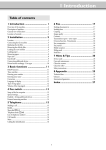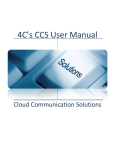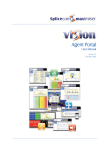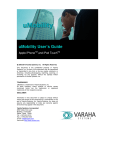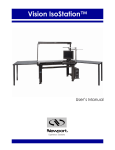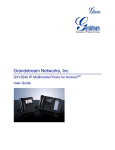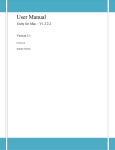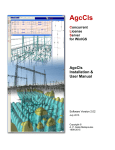Download Corporate Telephony Toolbar User Guide
Transcript
Corporate Telephony Toolbar User Guide Corporate telephony toolbar user guide 1 Table of Contents 1 Introduction.............................................................................................................................................................6 1.1 About Corporate Telephony Toolbar���������������������������������������������������������������������������������������������������������������������������� 6 1.2 About This Guide���������������������������������������������������������������������������������������������������������������������������������������������������������� 6 1.3 Accessing The Toolbar������������������������������������������������������������������������������������������������������������������������������������������������� 6 1.4 First Time Login������������������������������������������������������������������������������������������������������������������������������������������������������������ 6 1.5 Subsequent Access���������������������������������������������������������������������������������������������������������������������������������������������������� 10 2 Using Toolbar........................................................................................................................................................11 2.1 The Toolbar.................................................................................................................................................................. 11 2.2 Make a Call.................................................................................................................................................................. 15 2.2.1 Dial Number�������������������������������������������������������������������������������������������������������������������������������������������������������� 15 2.2.2 Dial from Web Page�������������������������������������������������������������������������������������������������������������������������������������������� 15 2.2.3 Dial from Contact List����������������������������������������������������������������������������������������������������������������������������������������� 16 2.2.4 Dial from vCard��������������������������������������������������������������������������������������������������������������������������������������������������� 16 2.2.5 Dial from Personal Directory������������������������������������������������������������������������������������������������������������������������������� 17 2.2.6 Dial from Group Directory����������������������������������������������������������������������������������������������������������������������������������� 17 2.2.7 Dial from Call History������������������������������������������������������������������������������������������������������������������������������������������ 18 2.2.8 Dial from Speed Dial Directory��������������������������������������������������������������������������������������������������������������������������� 18 2.2.9 Dial from Search������������������������������������������������������������������������������������������������������������������������������������������������� 19 2.3 Receive Call................................................................................................................................................................. 19 2.3.1 Answer Call��������������������������������������������������������������������������������������������������������������������������������������������������������� 19 2.3.2 Blind Transfer������������������������������������������������������������������������������������������������������������������������������������������������������ 20 2.3.3 Consulted Transfer���������������������������������������������������������������������������������������������������������������������������������������������� 20 2.3.4 Open URL����������������������������������������������������������������������������������������������������������������������������������������������������������� 21 2.3.5 Save vCard��������������������������������������������������������������������������������������������������������������������������������������������������������� 21 2.4 During a Call................................................................................................................................................................ 21 2.4.1 Hold Call.............................................................................................................................................................. 21 2.4.2 Initiate Three-Way Conference��������������������������������������������������������������������������������������������������������������������������� 22 2.5 Voice Mail..................................................................................................................................................................... 22 2.5.1 Transfer to Voice Mail����������������������������������������������������������������������������������������������������������������������������������������� 22 2.5.2 Check for New Voice Mail���������������������������������������������������������������������������������������������������������������������������������� 22 2.5.3 Retrieve Voice Mail��������������������������������������������������������������������������������������������������������������������������������������������� 22 2.6 Use Call History���������������������������������������������������������������������������������������������������������������������������������������������������������� 22 2.6.1 View Call Logs���������������������������������������������������������������������������������������������������������������������������������������������������� 23 2.6.2 Delete Call Logs�������������������������������������������������������������������������������������������������������������������������������������������������� 23 2.7 Enable and Disable Be Anywhere Locations������������������������������������������������������������������������������������������������������������� 24 3 Options Dialog������������������������������������������������������������������������������������������������������������������������������������������������������25 3.1 General Page............................................................................................................................................................... 25 3.2 Account Page.............................................................................................................................................................. 26 3.2.1 Password Change Dialog����������������������������������������������������������������������������������������������������������������������������������� 26 3.3 Connection Page�������������������������������������������������������������������������������������������������������������������������������������������������������� 27 3.4 Dialing Rules Page������������������������������������������������������������������������������������������������������������������������������������������������������ 28 3.4.1 Outlook Integration Page������������������������������������������������������������������������������������������������������������������������������������ 29 Corporate telephony toolbar user guide 2 3.4.2 Contacts Page���������������������������������������������������������������������������������������������������������������������������������������������������� 29 3.4.3 Updates Page����������������������������������������������������������������������������������������������������������������������������������������������������� 30 3.5 Web Screen Pop Page������������������������������������������������������������������������������������������������������������������������������������������������ 31 3.6 About Page.................................................................................................................................................................. 32 4 Services Dialog����������������������������������������������������������������������������������������������������������������������������������������������������33 4.1 Incoming Calls������������������������������������������������������������������������������������������������������������������������������������������������������������ 33 4.1.1 Anonymous Call Rejection��������������������������������������������������������������������������������������������������������������������������������� 33 4.1.2 Call Forwarding Always�������������������������������������������������������������������������������������������������������������������������������������� 34 4.1.3 Call Forwarding No Answer�������������������������������������������������������������������������������������������������������������������������������� 35 4.1.4 Call Forwarding Busy������������������������������������������������������������������������������������������������������������������������������������������ 36 4.1.5 Do Not Disturb���������������������������������������������������������������������������������������������������������������������������������������������������� 37 4.1.6 External Calling Line ID Delivery������������������������������������������������������������������������������������������������������������������������� 38 4.1.7 Internal Calling Line ID Delivery�������������������������������������������������������������������������������������������������������������������������� 39 4.2 Outgoing Calls������������������������������������������������������������������������������������������������������������������������������������������������������������ 40 4.2.1 Calling Line ID Delivery Blocking������������������������������������������������������������������������������������������������������������������������ 40 4.3 Call Control.................................................................................................................................................................. 40 4.3.1 Be Anywhere������������������������������������������������������������������������������������������������������������������������������������������������������� 41 4.3.2 Call Waiting��������������������������������������������������������������������������������������������������������������������������������������������������������� 43 4.3.3 Remote Office����������������������������������������������������������������������������������������������������������������������������������������������������� 43 4.4 Messaging.................................................................................................................................................................... 44 4.4.1 Voice Messaging������������������������������������������������������������������������������������������������������������������������������������������������� 44 5 Troubleshooting���������������������������������������������������������������������������������������������������������������������������������������������������45 5.1 Using Toolbar with Microsoft Windows Service Pack 2 (SP2)����������������������������������������������������������������������������������� 45 5.2 Toolbar Not Visible in Outlook������������������������������������������������������������������������������������������������������������������������������������ 46 5.3 Register Toolbar within Outlook��������������������������������������������������������������������������������������������������������������������������������� 46 5.4 I Have Not Been Licensed to Use Toolbar����������������������������������������������������������������������������������������������������������������� 46 5.5 Toolbar Not Visible in Internet Explorer���������������������������������������������������������������������������������������������������������������������� 48 6 Known Issues........................................................................................................................................................48 6.1 Outlook 2007 Limitation��������������������������������������������������������������������������������������������������������������������������������������������� 48 Index..........................................................................................................................................................................49 Table of figures Figure 1 The Toolbar in Internet Explorer........................................................................................................................... 6 Figure 2 The Toolbar in Mozilla Firefox............................................................................................................................... 6 Figure 3 The Toolbar in Outlook......................................................................................................................................... 6 Figure 4 Options Dialog – Accounts Page������������������������������������������������������������������������������������������������������������������������ 7 Figure 5 Options Dialog – Connection Page��������������������������������������������������������������������������������������������������������������������� 7 Figure 6 Options Dialog – Update Page............................................................................................................................. 8 Figure 7 Options Dialog – General Page............................................................................................................................ 9 Figure 8 Change Password on First Login Dialog Box����������������������������������������������������������������������������������������������������� 9 Figure 9 Enabled Toolbar.................................................................................................................................................... 9 Figure 10 Login – Change Expired Password����������������������������������������������������������������������������������������������������������������� 10 Figure 11 Login – Your Password Will Expire Soon�������������������������������������������������������������������������������������������������������� 10 Corporate telephony toolbar user guide 3 Figure 12 Figure 13 Figure 14 Figure 15 Figure 16 Figure 17 Figure 18 Figure 19 Figure 22 Figure 23 Figure 24 Figure 25 Figure 26 Figure 27 Figure 28 Figure 29 Figure 30 Figure 31 Figure 32 Figure 33 Figure 34 Figure 35 Figure 36 Figure 37 Figure 38 Figure 39 Figure 40 Figure 41 Figure 42 Figure 43 Figure 44 Figure 46 Figure 47 Figure 48 Figure 49 Figure 50 Figure 51 Figure 52 Figure 53 Figure 54 Figure 55 Figure 56 Figure 57 Figure 58 Figure 59 The Toolbar (Outlook)....................................................................................................................................... 11 Login Button..................................................................................................................................................... 11 Options Button................................................................................................................................................. 11 Services Button................................................................................................................................................ 11 Portal Auto-Login Button.................................................................................................................................. 11 Anywhere Drop-down List................................................................................................................................ 11 Anywhere Drop-down List Expanded Listing Available Locations����������������������������������������������������������������� 12 Remote Office Button....................................................................................................................................... 12 Call Forwarding Always Service Button���������������������������������������������������������������������������������������������������������� 12 Call Forwarding No Answer Service Button���������������������������������������������������������������������������������������������������� 12 Call Forwarding Busy Service Button������������������������������������������������������������������������������������������������������������� 12 Do Not Disturb Service Button......................................................................................................................... 12 Speed Dial Directory Button............................................................................................................................. 13 Call History Button............................................................................................................................................ 13 Personal Directory Button................................................................................................................................ 13 Group Directory Button.................................................................................................................................... 13 Search Button................................................................................................................................................... 13 The Toolbar Drop-down List............................................................................................................................. 13 Dial Contact Drop-down List............................................................................................................................ 13 Dial Number Combo Box................................................................................................................................. 13 Answer Button.................................................................................................................................................. 14 Hold Button....................................................................................................................................................... 14 Transfer to Voice Mail Button........................................................................................................................... 14 Transfer to Voice Mail Button with Voice Mail Waiting Indication������������������������������������������������������������������� 14 Blind Transfer Button........................................................................................................................................ 14 Conference Call Button.................................................................................................................................... 14 End Call Button................................................................................................................................................. 14 Call Lines Drop-down List................................................................................................................................ 14 Dial Number Box.............................................................................................................................................. 15 Redial Previous Number................................................................................................................................... 15 Dialing from Web Page..................................................................................................................................... 15 Dialing from Contact List.................................................................................................................................. 16 Dialing from vCard............................................................................................................................................ 16 Dialing from Outlook 2007/2010 vCard����������������������������������������������������������������������������������������������������������� 17 Personal Directory............................................................................................................................................ 17 Group Directory................................................................................................................................................ 18 Call History........................................................................................................................................................ 18 Speed Dial Directory......................................................................................................................................... 18 Search Bar........................................................................................................................................................ 19 Search Bar History............................................................................................................................................ 19 Call Notification................................................................................................................................................ 20 Transfer Button................................................................................................................................................. 20 Opening URL through Call Notification����������������������������������������������������������������������������������������������������������� 21 Saving vCard through Call Notification����������������������������������������������������������������������������������������������������������� 21 Hold Button....................................................................................................................................................... 21 Corporate telephony toolbar user guide 4 Figure 61 Transfer to Voice Mail Button........................................................................................................................... 22 Figure 62 Transfer to Voice Mail Button Indicating New Voice Mail������������������������������������������������������������������������������� 22 Figure 63 Call History Button............................................................................................................................................ 23 Figure 64 Viewing Call History.......................................................................................................................................... 23 Figure 65 The Toolbar – Anywhere Locations����������������������������������������������������������������������������������������������������������������� 24 Figure 67 Options Dialog – General Page........................................................................................................................ 25 Figure 68 Options Dialog – Account Page....................................................................................................................... 26 Figure 69 Options Dialog – Password Change��������������������������������������������������������������������������������������������������������������� 26 Figure 70 Options Dialog – Connections Page��������������������������������������������������������������������������������������������������������������� 27 Figure 71 Options Dialog – Dialing Rules Page��������������������������������������������������������������������������������������������������������������� 28 Figure 72 Options Dialog – Outlook Integration Page����������������������������������������������������������������������������������������������������� 29 Figure 73 Options Dialog – Contacts Page...................................................................................................................... 29 Figure 74 Options Dialog – Update Page......................................................................................................................... 30 Figure 77 Options Dialog – Web Screen Pop Page�������������������������������������������������������������������������������������������������������� 31 Figure 78 Options Dialog – About Page........................................................................................................................... 32 Figure 79 Services Dialog – Anonymous Call Rejection Page���������������������������������������������������������������������������������������� 33 Figure 80 Services Dialog – Call Forwarding Always Page��������������������������������������������������������������������������������������������� 34 Figure 81 Services Dialog – Call Forwarding No Answer Page�������������������������������������������������������������������������������������� 35 Figure 82 Services Dialog – Call Forwarding Busy Page������������������������������������������������������������������������������������������������ 36 Figure 83 Services Dialog – Do Not Disturb Page���������������������������������������������������������������������������������������������������������� 37 Figure 84 Services Dialog – External Calling Line ID Delivery Page������������������������������������������������������������������������������� 38 Figure 85 Services Dialog – Internal Calling Line ID Delivery Page�������������������������������������������������������������������������������� 39 Figure 92 Services Dialog – Outgoing Calls: Calling Line ID Delivery Blocking������������������������������������������������������������ 40 Figure 93 Services Dialog – Call Control: VoiceEdge Anywhere����������������������������������������������������������������������������������� 41 Figure 94 VoiceEdge Anywhere Available Portals List���������������������������������������������������������������������������������������������������� 42 Figure 95 Services Dialog – Call Control: Call Waiting���������������������������������������������������������������������������������������������������� 43 Figure 95 Services Dialog – Call Control: Remote Office����������������������������������������������������������������������������������������������� 43 Figure 97 Services Dialog – Messaging: Voice Messaging��������������������������������������������������������������������������������������������� 44 Figure 98 Internet Explorer Warning................................................................................................................................. 45 Figure 99 Internet Explorer Warning................................................................................................................................. 45 Figure 100 Internet Explorer Security Warning��������������������������������������������������������������������������������������������������������������� 45 Figure 101 Outlook Toolbar Options................................................................................................................................ 46 Figure 102 Help Dialog, Disabled Items........................................................................................................................... 46 Figure 103 Disabled Items Dialog..................................................................................................................................... 47 Figure 104 License Notification........................................................................................................................................ 47 Figure 105 Internet Explorer Toolbar Options����������������������������������������������������������������������������������������������������������������� 48 Corporate telephony toolbar user guide 5 1. introduction 1.1 About Corporate Telephony Toolbar The Corporate Telephony Toolbar is a carrier-class, lightweight desktop communications management product for everyday users of Microsoft Outlook, Microsoft Internet Explorer, or Mozilla Firefox with the VoiceEdge platform. With this product you can manage your incoming and outgoing messages, maintain up-to-date connection information, and configure controls on your calls and voice mail. 1.2 About This Guide This guide provides step-by-step procedures and reference information for Corporate Telephony Toolbar Release 17.0sp4 MB1. In this document, Corporate Telephony Toolbar is interchangeably referred to as the Toolbar. 1.3 Accessing The Toolbar The Toolbar is an add-in to Microsoft Internet Explorer, Outlook, and Mozilla Firefox, and provides a toolbar to access VoiceEdge Service and Call Management features within your web browser and mail client. When you open Internet Explorer, Outlook, or Firefox you see the following toolbar. Most buttons are disabled until you log in by clicking on the “power” button at the left end of the Toolbar. Figure 1. The Toolbar in Internet Explorer Figure 2. The Toolbar in Mozilla Firefox Figure 3. The Toolbar in Outlook 1.4 First Time Login Logging in to Toolbar identifies you to the servers that manage your phone services. This is so you can receive, initiate, and control calls directly from your computer. When you log in for the first time, you need to configure your connection settings as described in the following steps. Once these settings are configured, you do not need to provide them again. You can log in directly from the toolbar by clicking Login. 1)Click Login on the toolbar. Toolbar opens the Options dialog. 2)Click Account. 3) To configure your account settings, enter, in the provided fields, the user name and password provided by your administrator for your Toolbar account. Corporate telephony toolbar user guide 6 4) Check the Save Username and Save Password options if you want to avoid being prompted for this information next time you log in. Your password is encrypted for greater security. 5)Click Apply. Figure 4. Options Dialog – Accounts Page 6) Configure your server connection by clicking Connection. 7) The server URL and port number will be appropriately prepopulated. Consult VoiceEdge Customer Care if values are not displayed. 8)Click Apply. Figure 5. Options Dialog – Connection Page Corporate telephony toolbar user guide 7 9) If you use a proxy server to access the internet, click Updates. 10)Enter the proxy server information in the fields provided. Consult your system administrator for the necessary values. 11)Click Apply. Figure 6. Options Dialog – Update Page NOTE: The proxy server is not used to connect to VoiceEdge for telephony services; it is used only to silently check for available Toolbar upgrades. 12)To configure your general settings, click General. 13)Check Auto login on start-up to have Toolbar connect automatically to the VoiceEdge server when you start Internet Explorer, Firefox, or Outlook. 14)Check the Auto login when connected to network to have Toolbar connect automatically to the VoiceEdge server when a network connection is available. 15)The Language drop-down offers English (U.S.). 16) Synchronize language with service profile, when checked, enables Toolbar to automatically match the application language to the language set within the VoiceEdge subscriber’s profile after signing in. NOTE: If no profile match is found, the language remains set to the current language. 17)Click OK. Corporate telephony toolbar user guide 8 Figure 7. Options Dialog – General Page 18)Click Login again. If Toolbar is configured with password expiry option, you are presented with the Change Password dialog box. This is your first login attempt or your password has expired. You must change your password before proceeding. Figure 8. Change Password on First Login Dialog Box 19)Enter your old password, and your new password twice in the spaces provided. If your configuration and credentials are correct, you are connected to the VoiceEdge server and the buttons on your toolbar are enabled. NOTE: The buttons are enabled if their respective services are assigned. Figure 9. Enabled Toolbar Corporate telephony toolbar user guide 9 1.5 Subsequent Access Once you have configured The Toolbar with the settings it needs to connect to VoiceEdge, you can be automatically logged in when you start Internet Explorer, Firefox, or Outlook without having to provide that information again. The VoiceEdge online tools are configured with an Initial Password Expiry option, so if the toolbar is your first attempt to login, you may be prompted to change your password upon log in. If your password is new or has expired, the following dialog box appears, after you click Login. Figure 10. Login – Change Expired Password If your password has not expired yet but will expire soon, the following dialog box appears: Figure 11. Login – Your Password Will Expire Soon 1) Enter your old password. 2) Enter your new password twice, to confirm it. 3)Click OK. 4) Or, if your password has not expired yet, click Cancel to cancel password change. In both cases, you are logged into Toolbar. If you have not changed your password, you are prompted to do so when you log in again. NOTE 1:If your password has expired, the Cancel button is disabled forcing you to change your password before you are logged in to Toolbar. NOTE 2:All fields in the Password Change dialog box are mandatory. Corporate telephony toolbar user guide 10 2. Using Toolbar When you have successfully logged in to Toolbar, most of the buttons on your toolbar are enabled. 2.1 The Toolbar Figure 12. The Toolbar (Outlook) Detailed Description of Buttons Login: Logs in and out of Toolbar. The color of this icon indicates your login status. A grey icon indicates that you are not logged in. A green icon shows that you are currently logged in. A disabled button shows that Toolbar is attempting to log in. A red login icon indicates that your last login attempt failed or you are logged out. Figure 13. Login Button Options: You can configure your VoiceEdge account, connection settings, and dialing rules through this dialog. This icon is highlighted when open. Figure 14. Options Button Services: You can configure the Call Management services provided by Toolbar. This icon is highlighted when in use. Figure 15. Services Button Portal Auto-Login: Logs you in to your web portal from Microsoft Internet Explorer or Mozilla Firefox. Figure 16. Portal Auto-Login Button Be Anywhere: Displays the list of all available VoiceEdge Anywhere locations configured in the system and allows you to enable or disable VoiceEdge Anywhere locations by clicking to the left of the location entries. An enabled location has a check mark beside it. Figure 17. Anywhere Drop-down List Corporate telephony toolbar user guide 11 Figure 18. Anywhere Drop-down List Expanded Listing Available Locations Remote Office: When activated, this service allows you to use an alternate phone, such as a mobile, home, or hotel phone, as your main business phone. When this service is enabled, the icon is highlighted. If Remote Office is not yet configured when you use this icon, Toolbar opens the Services dialog to the Remote Office page so you can configure the service. Figure 19. Remote Office Button Call Forward Always service automatically forwards all incoming calls to a specified phone number. When this service is enabled, this icon remains highlighted. If Call Forward Always is not yet configured when you use this icon to activate the service, Toolbar opens the Service dialog to the Call Forwarding Always page for you to configure the service. Figure 22. Call Forwarding Always Service Button Call Forward No Answer service automatically forwards all incoming calls to a specified phone number when you do not answer within a specified number of rings. While the service is enabled, the icon remains highlighted. Figure 23. Call Forwarding No Answer Service Button Call Forward Busy service forwards all incoming calls to a specified phone number when you are busy on other calls. While the service is enabled, this icon remains highlighted. If Call Forward Busy is not yet configured when you use this icon to activate the service, Toolbar opens the Services dialog to the Call Forwarding Busy page for you to configure the service. Figure 24. Call Forwarding Busy Service Button Do Not Disturb service automatically forwards all incoming calls to your Voice Messaging service, or plays callers a busy tone if you do not have a Voice Messaging service configured. While the service is enabled, this icon remains highlighted. Figure 25. Do Not Disturb Service Button Corporate telephony toolbar user guide 12 Speed Dial Directory allows you to dial phone numbers saved in your speed dial list by clicking them with your mouse. Figure 26. Speed Dial Directory Button Call History lists your most recent received, missed, and dialed calls. Figure 27. Call History Button Personal Directory allows you to dial phone numbers saved in your personal directory by clicking them. Figure 28. Personal Directory Button Group Directory permits you to dial phone numbers in your group directory by clicking them. Figure 29. Group Directory Button Search hunts in the group, personal, Outlook Express directories for the text you enter. Figure 30. Search Button The VoiceEdge drop-down list contains URLs preconfigured to quickly link to additional training and support information. Select an item from the list to navigate to that page in your web browser. Figure 31. The Toolbar Drop-down List Dial Contact dials the business, home, or mobile number of a selected contact within Microsoft Outlook. Figure 32. Dial Contact Drop-down List Dial Number dials a specified number. Figure 33. Dial Number Combo Box Corporate telephony toolbar user guide 13 Answer answers an incoming call. Figure 34. Answer Button Hold puts the current call on hold. Figure 35. Hold Button Transfer to Voice Mail transfers the current call to your Voice Messaging service. If the color of the envelope icon on the Transfer to Voice Mail button changes, as illustrated in Figure 37, then a new voice mail is available. Figure 36. Transfer to Voice Mail Button Figure 37. Transfer to Voice Mail Button with Voice Mail Waiting Indication Blind Transfer transfers the current call to another phone number. Figure 38. Blind Transfer Button Conference Call starts a conference call that can include up to 3 callers. This button only becomes enabled when you are connected to two other parties at the same time. Figure 39. Conference Call Button End Call ends the current call. Figure 40. End Call Button Call Lines lists your phone numbers you are currently connected to. Figure 41. Call Lines Drop-down List Corporate telephony toolbar user guide 14 2.2Make a Call 2.2.1 Dial Number To dial a new number: 1) Type the number in the Dial Number box. 2) To place the call, press ENTER. 3) To end the call, click End. Figure 42. Dial Number Box To redial a previously dialed number: 1) Select a number by clicking on the arrow at the right-hand side of the Dial Number box. A list of up to 10 previously dialed numbers is displayed. 2) Click on a number in the Dial Number list. 3) To place the call, press ENTER. 4) To end the call, click End. Figure 43. Redial Previous Number 2.2.2 Dial from Web Page To dial from a web page: 1) Select the phone number displayed on a web page. 2) Highlight the number with your mouse. 3) Right-click the highlighted phone number and select Dial from the pop-up window. Figure 44. Dialing from Web Page Corporate telephony toolbar user guide 15 2.2.3 Dial from Contact List With The Toolbar you can dial the home, business, or mobile number of any contact directly within Outlook. 1)Click Contact in the folder list. 2) Select the contact you wish to call from the contact list. 3) Click the arrow at the right-hand side of the Dial Contact drop-down list, on the Toolbar within Outlook. 4) Select the type of number to call. Figure 46. Dialing from Contact List 2.2.4 Dial from vCard To dial from a vCard in Outlook 2000/2002/2003: 1)Click Contacts in the folder list. 2) Double-click the contact you want to call. Outlook opens the contact’s vCard. 3) Click the arrow at the right-hand side of the Dial Contact drop-down list, on the Toolbar within Outlook. 4) Select the type of number to call. Figure 47. Dialing from vCard Corporate telephony toolbar user guide 16 To dial from a vCard in Outlook 2007/2010: 1)Click Contacts in the folder list. 2) Double-click the contact you want to call. Outlook opens the contact’s vCard. 3) Click the Telephony Toolbar tab. 4) Select the type of number to call. Figure 48. Dialing from Outlook 2007/2010 vCard NOTE: If there is no number specified for a contact, but you click on the Home, Business, or Mobile buttons in your vCard ribbon, a message appears stating “No number is specified for this contact”. This is, by design, a limitation of Microsoft Outlook. 2.2.5 Dial from Personal Directory You can directly dial any number stored in your personal directory as it is integrated with the contacts in Toolbar. 1) To open the personal directory, click Personal Directory on the Toolbar. This page can be printed using the host application. Users with Microsoft Windows XP Service Pack 2 installed may encounter a warning when opening the Personal Directory. For more information, see section 6 Troubleshooting. 2) To sort the personal directory, click on a column header. The table is sorted, in descending order, according to the information in the column you selected. 3) To change the sort order between descending and ascending, click on the same column header again. 4) To dial a number from the personal directory, click on the desired phone number. Toolbar places the call. Figure 49. Personal Directory 2.2.6 Dial from Group Directory You can directly dial any number stored in your group directory that integrates the group contacts, provided by the VoiceEdge platform, with Toolbar. 1)Click Group Directory on the Toolbar. This list can be printed using the host application. Users with Microsoft Windows XP Service Pack 2 installed may encounter a warning when opening the Group Directory. For more information, see section 6 Troubleshooting. 2) To sort the group directory, click on a column header. The table is sorted, in descending order, according to the information in the column you selected. 3) To change the sort order between descending and ascending, click on the same column header again. 4) To dial a number from the group directory, click on the desired phone number. Toolbar places the call. Corporate telephony toolbar user guide 17 Figure 50. Group Directory 2.2.7 Dial from Call History Call History allows users to view their missed calls, received calls, and dialed calls. These are listed in reverse chronological order. 1) To open the Call History, click Call History on the toolbar. 2) To dial from the call history, click on the desired phone number. Toolbar automatically places the call. Figure 51. Call History 2.2.8 Dial from Speed Dial Directory You can dial from the speed dial directory. 1) To open the Speed Dial Directory, click Speed Dial Directory on the Toolbar. 2) To dial from the speed dial directory, click the desired phone number and Toolbar places the call. Figure 52. Speed Dial Directory Corporate telephony toolbar user guide 18 2.2.9 Dial from Search Use the Search drop-down list to search for a user or contact. The search results include all users in the Group, Personal, and Outlook Express directories, if configured to do this. Your search returns all users that match your criteria in any field. For example, if you enter “sa” as your criteria, your search might return users with the first name “Sally” or with the last name “Sanders” as well as users in the department “sales”. You can also search for users by phone number. To search for a user: 1) Type your criteria in the Search box. 2) Press ENTER to execute the search. Toolbar displays the results of your search. 3) Click the phone number you want to dial. 4) To end the call, click End. Figure 53. Search Bar To re-execute a previous search: 1) Select a previous search criteria by clicking on the arrow at the right-hand side of the Search box. A list of previous search criteria is displayed. 2) Select an item in the list. Toolbar displays the results of your search. 3) Click the phone number you want to dial. 4) To end the call, click End. Figure 54. Search Bar History 2.3Receive Call 2.3.1 Answer Call NOTE: You can only answer a call via Toolbar if you have an Advanced Call Control (ACC) compliant phone, like a VoiceEdge IP telephone handset. When you receive a call, Toolbar displays a call notification window on top of the system tray. You can answer this call by picking up your handset from the Toolbar or by clicking the call notification (only if you have an Advanced Call Control (ACC) compliant phone). • To answer a call from Toolbar, click Answer. • To answer a call from the call notification, click on it. When using The Toolbar with Outlook, if the incoming call does not provide a name for the calling party, Toolbar checks the number against your Outlook contacts and displays the corresponding name if it finds a match. You can also transfer the caller to your Voice Mail, save a vCard for the caller, open a URL populated with the caller’s number, or end the call directly from the call notification. Corporate telephony toolbar user guide 19 2.3.1.1Call Notification When you initiate or receive a call, Toolbar displays a notification window above the system tray, which includes the other party’s phone number and other information about the call. Clicking the hyperlinked text in the call notification automatically answers the call. The call notification stays open for the duration of the alerting call. If you initiate or receive another call while the first notification is open, the call notifications stack on top of one another. Figure 55. Call Notification 2.3.2Blind Transfer Use this method to transfer a call to another specified number without providing an introduction to the destination party. Calls may be transferred this way while active, held, or ringing on your phone. In the latter case, the system redirects the call before it is answered. 1) 2) 3) If the first party is not already on the line, dial a number on your phone or select a number using any of the methods described in section 3.2 Make a Call. Call the second number. This automatically puts the first party on hold if the first party is not already on hold. Initiate the transfer by clicking Transfer on the toolbar. The parties are now connected. Figure 56. Transfer Button 2.3.3 Consulted Transfer Use this method to transfer a call to another specified number and (optionally) provide an introduction to the destination party. Calls may be transferred this way while active, held, or ringing on your phone. When a supervised transfer is initiated, the primary call is placed on hold and a call is made to the party intended to receive the call. The receiving party may be consulted prior to accepting the call. 1) 2) 3) If the first party is not already on the line, dial a number on your phone or select a number using any of the methods described in section 3.2 Make a Call. Call the second number. This automatically puts the first party on hold. Wait until the called party accepts your call, and then click Transfer to connect the parties. Corporate telephony toolbar user guide 20 2.3.4 Open URL When you receive a call, Toolbar displays a call notification window on top of the system tray. To open a URL in your browser, click Web Pop URL in the call notification. This opens a page in your browser window that contains information about the calling party encoded in its URL. Figure 57. Opening URL through Call Notification You can also transfer the caller to your Voice Mail, save a vCard for the caller, open a URL populated with the caller’s number, or end the call directly from the call notification. 2.3.5 Save vCard When you receive a call, Toolbar displays a call notification window on top of the system tray. You can click a button in this notification to save the caller’s phone number and personal information as a vCard in Outlook. To do this, click Add vCard in the call notification. Figure 58. Saving vCard through Call Notification You can also transfer the caller to your Voice Mail, save a vCard for the caller, open a URL populated with the caller’s number, or end the call directly from the call notification. 2.4 During a Call 2.4.1Hold Call 1) To hold a call, click Hold on the toolbar. The Hold button is grayed out to indicate the held status of the call. 2) To resume a held call, click Answer (highlighted) on the toolbar. The hold returns to its normal state to indicate the active status of the call. Figure 59. Hold Button Corporate telephony toolbar user guide 21 2.4.2 Initiate Three-Way Conference NOTE: You must have the Three-Way Call service assigned to you to use this feature. You can initiate a conference with two other parties directly from the toolbar. To establish two simultaneous active calls, you must have only two phone numbers listed in the Call Lines drop-down list. These calls may have been initiated either by you or by the other parties. 1) To start the conference, click Three-Way Conference on the toolbar. 2) To drop only one participant from the conference, select the participant’s number from the Call Lines drop-down list and click End. 2.5 Voice Mail 2.5.1 Transfer to Voice Mail You can transfer calls to your Voice Mail from the toolbar and from the call notification window. To transfer a call to Voice Mail from the Toolbar, click Transfer to Voice Mail on the toolbar. Figure 61. Transfer to Voice Mail Button To transfer a call to Voice Mail from the call notification, click the Transfer to Voice Mail icon in the notification window. 2.5.2 Check for New Voice Mail If the color of the envelope icon on the Transfer to Voice Mail button changes, then a new voice mail is available. Otherwise the envelope is grayed out. Figure 62. Transfer to Voice Mail Button Indicating New Voice Mail 2.5.3Retrieve Voice Mail Make sure that you are not currently engaged in a call. No entries must be present on the Call Lines drop-down list. Transfer yourself to your Voice Mail by clicking the Transfer to Voice Mail button on the toolbar. 2.6 Use Call History You can view and delete old call logs using the Call History feature. You can also make calls from Call History. Viewing and deleting call logs is described in the remainder of this section. For more information about making calls, see section 3.2.8 Dial from Call History. Corporate telephony toolbar user guide 22 2.6.1 View Call Logs To view call logs, click Call History on the toolbar. Figure 63. Call History Button The Call History window appears where you can view your dialed, received, and missed calls. Figure 64. Viewing Call History 2.6.2 Delete Call Logs To delete selected call logs: 1) Select the calls you want to clear, by checking the corresponding check-boxes. Alternatively, to select all calls in a specific call log (Dialed Call, Received Calls, or Missed Calls), click the corresponding Select All button. 2) Click the corresponding Clear button. To clear all call logs in all log categories: Click Clear All, at the top-right of the Call History window. NOTE 1:When you select Clear or Clear All, a warning message appears. When you click OK, the delete request is executed. When you click Cancel, it ignores the request. (This warning message may differ depending on how it was configured by your system administrator.) NOTE 2:You need to refresh the Call Log History to view the changes. Corporate telephony toolbar user guide 23 2.7Enable and Disable Be Anywhere Locations You use the Be Anywhere menu item on the Telephony toolbar to enable or disable Be Anywhere locations. This drop-down menu shows the list of all available locations configured in the system. An item in the menu shows the phone number, the description, and the enabled/disabled state of that location. If the location is enabled, it is checked. 1) To enable a location, click to the left of that location. A check mark appears next to the location. 2) To disable a location, click the check mark next to it. Figure 65. The Toolbar – Anywhere Locations Corporate telephony toolbar user guide 24 3. Options Dialog The Options dialog allows you to configure the connection and account settings that Toolbar uses to communicate with the VoiceEdge platform. The left-hand side of the dialog contains a tree view, listing the configuration pages you can access. The configuration pages you select in the tree view are displayed on the right. 1)Click OK to save all changes and close the dialog. 2)Click Apply to save all changes without closing the dialog. Cancel closes the dialog without saving your changes. 3.1 General Page The General page allows you to configure the automatic login behavior of Toolbar. Figure 67. Options Dialog – General Page • Auto login when connected to network automatically logs in to VoiceEdge when it detects an active network connecting on your computer. • Hide Call Notification disables the call notification window. When this box is checked, the call notification does not appear when Toolbar detects an incoming or outgoing call. The Language options are as follows: •The Language drop-down default is English (U.S.). Corporate telephony toolbar user guide 25 3.2 Account Page The Account page allows you to specify your VoiceEdge user name and password. Figure 68. Options Dialog – Account Page Contact VoiceEdge Customer Care or Technical Administrator if you do not know the appropriate settings. Once you successfully log in, the controls on this page become inactive. • • Save Username determines whether Toolbar saves the user name you provide. Check this box to avoid having to specify your user name each time you log in to the program. Save Password determines whether Toolbar saves the password you provide above. Check this box to avoid having to specify your password each time you log in to Toolbar. Toolbar encrypts your password for greater security. 3.2.1Password Change Dialog Click Change Password on the Options Dialog – Account page to display the Password Change dialog. Figure 69. Options Dialog – Password Change Corporate telephony toolbar user guide 26 To change your password: 1) On the toolbar, click Options. Toolbar opens the Options dialog. 2)Click Accounts. 3) On the Account page, click Change Password. The Password Change dialog box appears. 4) In the text boxes, enter your old password and then your new password twice. 5)Click OK. To cancel you changes, click Cancel. NOTE: All fields in the Password Change dialog box are mandatory. 3.3 Connection Page The Connection page should have default settings displayed for the network address of the VoiceEdge server that Toolbar connects to. Figure 70. Options Dialog – Connections Page Contact VoiceEdge Customer Care if you do not know the appropriate settings. Once you successfully log in, the controls on this page become inactive. • Host Address specifies the URL or IP address which Toolbar attempts to connect to when logging in. • Host Port is the port number used by the VoiceEdge server on the host specified above. Corporate telephony toolbar user guide 27 3.4 Dialing Rules Page The Dialing Rules page allows you to configure special dialing rules for Toolbar. Figure 71. Options Dialog – Dialing Rules Page To access an outside line for calls, dial specifies a prefix number that Toolbar includes automatically when dialing external numbers. If entered, this number is pre-pended only to dialed numbers that contain more than six digits. Up to five digits may be entered in this field. Valid characters are the numbers 0 to 9 and the symbol “+”. If you include the “+” character, it must be the first character in the field. Corporate telephony toolbar user guide 28 3.4.1 Outlook Integration Page The Outlook Integration page enables and disables the use of The Toolbar with Microsoft Outlook. As of Outlook 2007, you are unable to dial a contact in your in box using the right click-to-dial function. Figure 72. Options Dialog – Outlook Integration Page The Enable Outlook Integration check box, when checked, makes sure that the Outlook integration features are activated. 3.4.2 Contacts Page The Contacts page allows you to configure the way Toolbar integrates with your Outlook contact list. Figure 73. Options Dialog – Contacts Page Corporate telephony toolbar user guide 29 •The Retrieve contacts from default contact folder only option searches for and retrieves contacts stored in the default Contacts folder within Outlook. •The Retrieve all contacts option searches for and retrieves contacts stored in any Outlook folder. • Use Outlook contacts as preferred CLID lookup for incoming calls determines whether Toolbar uses the information saved in your Outlook contact list when displaying information about callers, instead of using group settings or other calling line ID information. 3.4.3 Updates Page The Updates page allows you to configure a web proxy server for Toolbar to use when connecting to the Internet. Figure 74. Options Dialog – Update Page Toolbar uses this proxy only when checking for product updates, not when connecting to the VoiceEdge server to provide Call Management features. Contact your VoiceEdge Customer Care or your Technical administrator if you do not know the appropriate settings. Use a proxy server to check for updates specifies whether a proxy server is required for Toolbar to access the internet. When this box is checked, the other settings on this page become enabled. • Type specifies the connection protocol used by the proxy server. The valid option is HTTP. • Server specifies the URL of the proxy server. • Port specifies the port number used by the proxy server. The default port of the HTTP protocol is 80. • User ID specifies a user ID authorized to use the proxy. • Password corresponds with the user ID mentioned above. Corporate telephony toolbar user guide 30 3.5 Web Screen Pop Page The Web Screen Pop page allows you to configure a web page that you can open from the call notification window. Figure 77. Options Dialog – Web Screen Pop Page The Web Screen Pop URL determines the URL that Toolbar opens using the default browser when you click Web Screen Pop in the Call Notification pop-up window. In addition to the URL, there are a number of optional parameters that the client can pass to the browser. The following list summarizes these parameters: • __USER__: The user’s VoiceEdge ID. (Note that in this case the “user” is the VoiceEdge subscriber.) • __FIRST__: The first name of the user. • __LAST__: The last name of the user. • __EMAIL__: The e-mail address of the user. • __GROUP__: The name of the VoiceEdge group the user belongs to. • __SERVICE_PROVIDER__: Comcast. • __PHONE__: The phone number of the user. • __REMOTE_PHONE__: The phone number of the remote party. • __REMOTE_NAME__: The name of the remote party (when available). • __CALL_TYPE__: “Incoming” or “Outgoing”. Corporate telephony toolbar user guide 31 3.6 About Page The About page displays the version, copyright notices, and product disclaimers associated with Toolbar. It can be useful when providing information to support representatives for VoiceEdge. Figure 78. Options Dialog – About Page The information displayed is as follows: • The Toolbar Version • The Toolbar Disclaimer The About information is important in providing information for the purpose of technical support. Corporate telephony toolbar user guide 32 4. Services Dialog The Services dialog allows you to configure the calling features provided by Toolbar, such as Voice Messaging, Call Forwarding, and Call Waiting. The left hand side of the dialog contains a tree view listing the configuration pages you can access. The configuration pages you select in the tree view are displayed on the right. •Click OK to save all changes and close the dialog. •Click Apply to save all changes without closing the dialog. •Click Cancel to close the dialog without saving your changes. NOTE: When the Services dialog is open, service buttons on the toolbar for the services that can be configured via the Services dialog do nothing when clicked. Once the Services dialog is closed, those buttons become operable again. 4.1 Incoming Calls The Incoming Calls pages in the Options dialog configure the services that apply to calls that you receive. 4.1.1 Anonymous Call Rejection The Anonymous Call Rejection service blocks all incoming calls from people who have restricted their phone numbers from being shown to their call recipients. Figure 79. Services Dialog – Anonymous Call Rejection Page Corporate telephony toolbar user guide 33 4.1.2 Call Forwarding Always The Call Forwarding Always service forwards all incoming calls to a specified phone number. To activate this service, click Call Forwarding Always on the toolbar. This highlights the button. Figure 80. Services Dialog – Call Forwarding Always Page Corporate telephony toolbar user guide 34 4.1.3 Call Forwarding No Answer The Call Forwarding No Answer service forwards all incoming calls to a specified phone number if you do not answer within a specified number of rings. Figure 81. Services Dialog – Call Forwarding No Answer Page To activate this service, click Call Forwarding No Answer on the toolbar. This is highlighted when turned on. Calls Forward to specifies the phone number to which Toolbar redirects all calls forwarded using this service. Numbers of rings before forwarding is the number of times your phone must ring before Toolbar forwards an incoming call. Corporate telephony toolbar user guide 35 4.1.4 Call Forwarding Busy The Call Forwarding Busy service forwards all incoming calls to a specified phone number when all available lines are in use. To activate this service, click Call Forwarding on the toolbar. This button becomes depressed when on. Figure 82. Services Dialog – Call Forwarding Busy Page Corporate telephony toolbar user guide 36 4.1.5 Do Not Disturb The Do Not Disturb service forwards all incoming calls to your Voice Messaging service. If you do not have a Voice Messaging service configured, callers hear a busy tone. Figure 83. Services Dialog – Do Not Disturb Page To activate this service, click Do Not Disturb on the toolbar. This is highlighted when in service. Play Ring Reminder when a call is forwarded determines whether Toolbar notifies you each time the Do Not Disturb service forwards a call to your Voice Messaging service. Corporate telephony toolbar user guide 37 4.1.6External Calling Line ID Delivery The External Calling Line ID Delivery service allows you to view the calling line information for incoming calls from external phone numbers. Figure 84. Services Dialog – External Calling Line ID Delivery Page Corporate telephony toolbar user guide 38 4.1.7 Internal Calling Line ID Delivery The Internal Calling Line ID Delivery service allows you to view the calling line information for incoming calls from members of your group. Figure 85. Services Dialog – Internal Calling Line ID Delivery Page Corporate telephony toolbar user guide 39 4.2 Outgoing Calls The Outgoing Calls pages in the Options dialog configure the services that apply to calls that you initiate. 4.2.1 Calling Line ID Delivery Blocking The Calling Line ID Delivery Blocking service prevents other parties from seeing your phone number or calling line information when engaged in calls with you. Figure 92. Services Dialog – Outgoing Calls: Calling Line ID Delivery Blocking 4.3Call Control The Call Control pages in the Options dialog allow you to configure your Call Control services. Corporate telephony toolbar user guide 40 4.3.1Be Anywhere The VoiceEdge Be Anywhere service allows you to define one or more network locations (also referred as VoiceEdge Anywhere locations) that can be used as extensions to your profile. Figure 93. Services Dialog – Call Control: VoiceEdge Anywhere Alert all locations for Click-to-Dial calls check box specifies whether Be Anywhere locations should be alerted for the Click-to-Dial service. Anywhere Locations List allows you to add, delete, or modify Be Anywhere Location phone numbers. Advanced Options per Location contains a list of advanced options that can be enabled or disabled separately for each Anywhere Location. Note: If you have Be Anywhere enabled, be sure to DISABLE Remote Office for the duration, as it will have a service interaction and not work as expected. − − − − Enable Diversion Inhibitor - This feature is not applicable. No need to enable. Require Answer Confirmation - Enabling this feature requires that the user press any button on their cell phone to accept a call. By doing this, in the event there is no answer the caller returns to your business voicemail box, and is not dropped into your cell phone voicemail. Use BroadWorks-based Call Control Services - This feature is not applicable. No need to enable. Outbound Alternate Number/SIP URI - This feature is not applicable. No need to enable. Corporate telephony toolbar user guide 41 View Available Portal List link displays the following page, which lists VoiceEdge Anywhere portals available to you. Figure 94. VoiceEdge Anywhere Available Portals List The page is read only. To return to the previous page, click OK. Corporate telephony toolbar user guide 42 4.3.2 Call Waiting The Call Waiting service allows you to answer incoming calls while engaged in another active call. Figure 96. Services Dialog – Call Control: Call Waiting 4.3.3Remote Office The Remote Office service allows you to substitute a different phone number for your office phone number. You can open this page by clicking Remote Office on the toolbar. The button is highlighted when turned on. Remote Office Number specifies the alternate phone number to substitute for your office number. Figure 95. Services Dialog – Call Control: Remote Office Corporate telephony toolbar user guide 43 4.4Messaging The Messaging pages in the Options dialog allow you to configure your Voice Messaging settings. 4.4.1 Voice Messaging The Voice Management page specifies how the system handles your voice messages. Figure 97. Services Dialog – Messaging: Voice Messaging You can select how you want the calls to be treated by selecting from the following: Send All Calls to Voice Mail, Send Busy Calls to Voice Mail, and Send Unanswered Calls to Voice Mail. Changes made via the web portal are not reflected in real time for The Toolbar. You must log in again to see the new values. When the Use unified messaging option is selected, you can access your voice messages via e-mail and phone. Messages are sent as mail attachments to the e-mail address configured for your account. “Use Phone Message Waiting Indicator” determines whether your phone provides an alternate dial tone and a visual indicator on some phone models to indicate that you have a message waiting. If the “Forward it to this e-mail address” option is selected you will be able to access your voice messages only by e-mail. Messages are sent as mail attachments to the specified e-mail address, and are not available for retrieval by phone. “Notify me by e-mail of the new voice message at this address” determines whether the system sends a notification e-mail to the specified address each time it records a voice mail. This notification will contain the date and time the voice message was recorded, but does not contain the content of the voice message itself as an attachment. Corporate telephony toolbar user guide 44 5. Troubleshooting This section contains information that may aid those having difficulty using Toolbar. If your problem is not listed in the index, contact VoiceEdge Customer Care for assistance. 5.1 Using Toolbar with Microsoft Windows Service Pack 2 (SP2) When you open the Group Directory or Personal Directory from the toolbar, Internet Explorer or Firefox may display the following warning message: Figure 98. Internet Explorer Warning This warning is triggered by the JavaScript used by Toolbar to sort directory listings. The following instructions override the warning and open the directory: 1) Click the message. The notification turns blue and displays a pop-up menu. 2)Select Allow Blocked Content from the pop-up menu. Figure 99. Internet Explorer Warning Another security warning appears. 3)Click Yes. Figure 100. Internet Explorer Security Warning Corporate telephony toolbar user guide 45 5.2 Toolbar Not Visible in Outlook If the Toolbar is not visible in Outlook, follow these steps. If the problem is not solved, contact VoiceEdge Customer Care. To confirm that The Toolbar is installed: 1) Open Internet Explorer. 2) Click the Options icon in the Toolbar. 3)Click General in the tree view on the left of the Options dialog. 4) Verify that the “version” area of the page lists Corporate Telephony Toolbar. If it lists only The Toolbar, contact VoiceEdge Customer Care to upgrade to The Toolbar. If it lists Corporate Telephony Toolbar follow the next step. Make the Toolbar visible: 1) Right-click an empty area of the toolbar region in Outlook. A menu appears listing all the toolbars currently registered. 2) Make sure that the Toolbar entries (Telephony Toolbar Call Control and Telephony Toolbar Services) are checked, as shown in Figure 101. Outlook Toolbar Options. Figure 101. Outlook Toolbar Options If the Toolbar entries are not listed, continue with the next step. 5.3Register Toolbar within Outlook 1) Click on Help or About Microsoft Office Outlook. Figure 102. Help Dialog, Disabled Items Corporate telephony toolbar user guide 46 2) In the dialog box select Disabled Items. If the Telephony Toolbar is visible on the list, click Enable and restart Outlook. Figure 103. Disabled Items Dialog 5.4 I Have Not Been Licensed to Use Toolbar This error indicates that Comcast has not added the Toolbar Client License to your list of services. Contact VoiceEdge Customer Care to activate Toolbar for your account. Figure 104. License Notification Corporate telephony toolbar user guide 47 5.5 Toolbar Not Visible in Internet Explorer If the Toolbar is not visible in Microsoft Internet Explorer, follow these steps: 1) 2) Right-click an empty area of the toolbar region in Explorer. A menu appears listing all the toolbars currently registered. Make sure that the Toolbar entries (Telephony Toolbar Call Control, Telephony Toolbar Services for The Toolbar) are checked, shown in Figure 105. Internet Explorer Toolbar Options. Figure 105. Internet Explorer Toolbar Options If your problem is still not solved, contact VoiceEdge Customer Care. 6. Known Issues This section specifies the known issues of The Toolbar. 6.1 Outlook 2007 Limitation When the user performs a search, or opens a directory (such as the group directory) using the Toolbar in Outlook 2007, Outlook 2007 creates multiple “Telephony Toolbar” listings under “My Contacts”. Only one of the entries is correct. Clicking on a duplicate entry displays an error message that says “The Operation Failed” and Outlook 2007 removes the entry. This is a side effect of Outlook 2007 shortcut folders and the error message can be ignored. Corporate telephony toolbar user guide 48 INDEX About, 32 About this guide, 6 Anonymous Call Rejection, 33 Answer button, 14 Answering calls, 19 Anywhere button, 11 Anywhere Locations, enabling and disabling, 24 Assistant Buttons, 11 Using, 11 Assistant–Enterprise drop-down list, 12 Blind Transfer, 20 Button, 14 BroadWorks Anywhere, 41 Buttons, Assistant, 11 Call Control, 40 BroadWorks Anywhere, 41 Remote Office, 43 Call Forwarding Always, 34 Call Forwarding Always button, 12 Call Forwarding Busy, 36 Call Forwarding Busy Service button, 12 Call Forwarding No Answer, 35 Call Forwarding No Answer Service button, 12 Call History, 22 Button, 13 Deleting call logs, 23 Dialing from, 18 Viewing call logs, 23 Call Lines button, 14 Call Notification, 20 Call, making, 15 Calling Line ID Delivery Blocking, 40 Calls Answering, 19 Holding, 21 Receiving, 19 Change password, 26 Checking for new Voice Mail, 22 Conference Call button, 14 Conference, initiating Three-Way, 22 Contact list, dialing from, 16 Contacts, Outlook Integration, 29 Dial Contact button, 13 Dial Number button, 13 Dialing From call history, 18 From contact list, 16 From group directory, 17 Corporate telephony toolbar user guide From personal directory, 17 From search, 19 From speed dial directory, 18 From vCard, 16 From web page, 15 New number, 15 Number, 15 Previously dialed number, 15 Rules, 28 Disabling Anywhere Locations, 24 Do Not Disturb, 37 Enabling Anywhere Locations, 24 End Call button, 14 External Calling Line ID Delivery, 38 First time login, 6 Group Directory Button, 13 Dialing from, 17 Hold button, 14 Holding call, 21 Incoming Calls Anonymous Call Rejection, 33 Call Forwarding Always, 34 Call Forwarding Busy, 36 Call Forwarding No Answer, 35 Do Not Disturb, 37 External Calling Line ID Delivery, 38 Internal Calling Line ID Delivery, 39 Initiating Three-Way Conference, 22 Internal Calling Line ID Delivery, 39 Known Issues, 48 Outlook 2007 Limitation, 48 Login Button, 11 First time, 6 Subsequent, 10 Making calls, 15 Messaging, 44 Voice, 44 New number, dialing, 15 Open BroadWorks Assistant–Enterprise, 6 Opening URL, 21 Options About, 32 Account page, 26 Button, 11 Call Control, 40 Connection page, 27 Dialing Rules, 28 49 INDEX Dialog, 25 General page, 25 Messaging, 44 Outlook Integration, 29 Updates page, 33 Web Screen Pop page, 31 Outgoing calls Calling Line ID Delivery Blocking, 40 Outlook Integration, 29 Contacts, 29 Password change, 26 Personal Directory Button, 13 Dialing from, 17 Portal Auto-Login button, 11 Previously dialed number, dialing, 15 Receiving calls, 19 Remote Office, 43 Button, 12 Retrieving Voice Mail, 22 Saving vCard, 21 Search Button, 13 Dialing from, 19 Services Anonymous Call Rejection, 33 BroadWorks Anywhere, 41 Call Forwarding Always, 34 Call Forwarding Busy, 36 Call Forwarding No Answer, 35 Calling Line ID Delivery Blocking, 40 Do Not Disturb, 37 External Calling Line ID Delivery, 38 Incoming Calls, 33 Internal Calling Line ID Delivery, 39 Remote Office, 43 Corporate telephony toolbar user guide Services button, 11 Speed Dial Directory Button, 13 Dialing from, 18 Subsequent login, 10 Supervised transfer, 20 Three-Way conference, initiating, 22 Transfer Blind, 20 Supervised, 20 To Voice Mail, 22 Transfer to Voice Mail button, 14 Troubleshooting, 45 Assistant not visible in Internet Explorer, 48 Assistant not visible in Outlook, 46 Assistant with Windows Service Pack 2, 48 Not licensed to use Assistant, 47 Registering Assistant within Outlook, 46 Updates page, 30 URL, opening, 21 vCard Dialing from in Outlook 2000/2002/2003, 16 Dialing from in Outlook 2007/2010, 17 Saving, 21 Voice Mail Checking for, 22 Retrieving, 22 Transferring to, 22 Voice Messaging, 44 Web page, dialing from, 15 Web Screen Pop, 31 50




















































